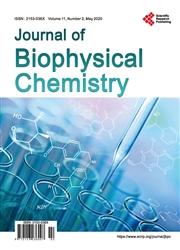A Unique Conformational Behaviour of Glutamine Peptides
引用次数: 0
Abstract
Trinucleotide repeat expansions (CAG) lead to increase in glutamine residues and hence increase in glutamine stretch. This leads to number of neurodegenerative diseases. Therefore, the conformation of poly Q of varying chain lengths has been investigated by quantum mechanical and molecular dynamics approaches. Glutamine contains amide linkage in the side chain. It is the interaction between side chain amide linkage and the peptide bond of the backbone which dictates the conformational behaviour. Some of the glutamine residues adopt phi psi values corresponding to poly-L-proline type II structure. Not more than three glutamine residues are found to have the same set of values and hence polyglutamine is adopting random coil structure. Carbonyl-carbonyl, CH-O interactions and hydrogen bond formation involving backbone and side chain amide chain linkages are found to contribute to the stability of the adopted structure. In simulation studies due to interaction of water molecules with the amide linkages the values undergo change and this leads to weakening of carbonyl-carbonyl interactions and hydrogen bonds. The conformational behaviour of polyglutamine peptides is shown to be chain length dependent and this may provide some insight regarding the aggregation behaviour of proteins containing poly Q stretch. Possibly this is the first systematic study of the conformational behaviour of polyglutamine peptides.谷氨酰胺肽的独特构象行为
三核苷酸重复扩增(CAG)导致谷氨酰胺残基增加,从而增加谷氨酰胺拉伸。这导致了许多神经退行性疾病。因此,采用量子力学和分子动力学的方法研究了不同链长的聚Q的构象。谷氨酰胺在侧链中含有酰胺键。侧链酰胺键与主链肽键之间的相互作用决定了其构象行为。一些谷氨酰胺残基采用与聚l -脯氨酸II型结构相对应的phi - psi值。发现不超过三个谷氨酰胺残基具有相同的一组值,因此多谷氨酰胺采用随机线圈结构。羰基-羰基、CH-O相互作用以及涉及主链和侧链酰胺链连接的氢键形成有助于所采用结构的稳定性。在模拟研究中,由于水分子与酰胺键的相互作用,这些值发生了变化,这导致羰基-羰基相互作用和氢键的减弱。聚谷氨酰胺肽的构象行为被证明是链长依赖的,这可能为含有聚Q拉伸的蛋白质的聚集行为提供一些见解。这可能是第一次系统地研究聚谷氨酰胺肽的构象行为。
本文章由计算机程序翻译,如有差异,请以英文原文为准。
求助全文
约1分钟内获得全文
求助全文

 求助内容:
求助内容: 应助结果提醒方式:
应助结果提醒方式:


